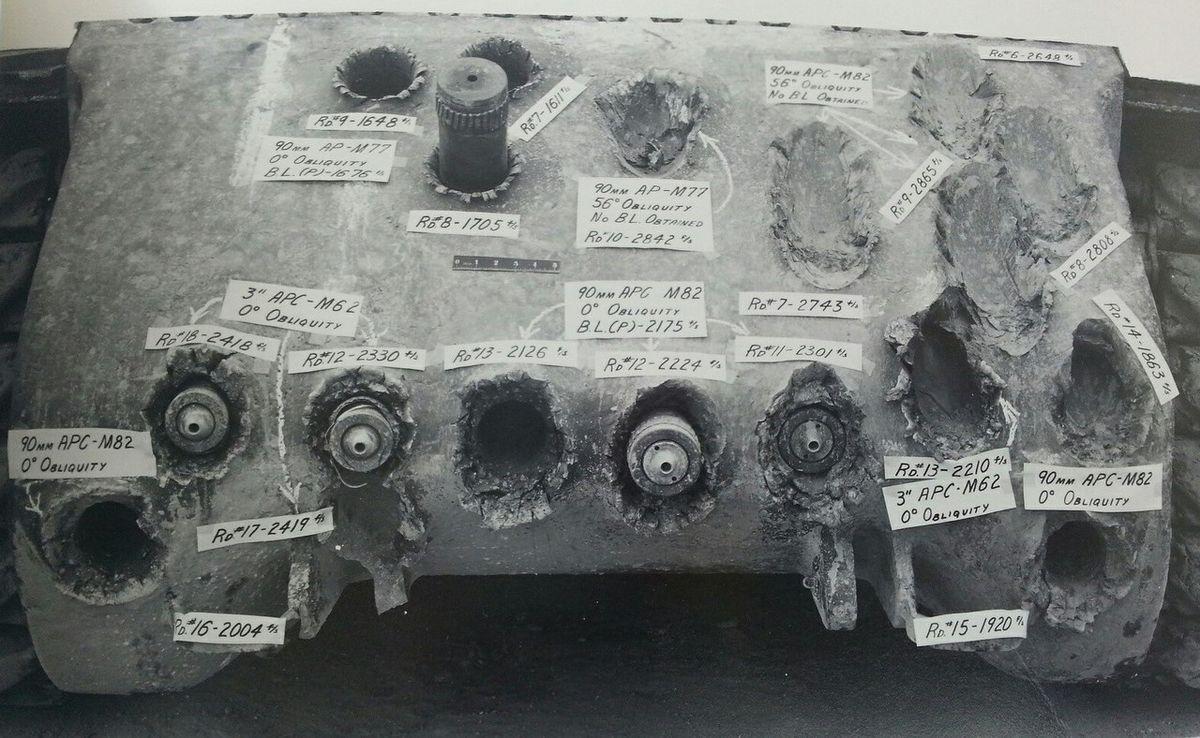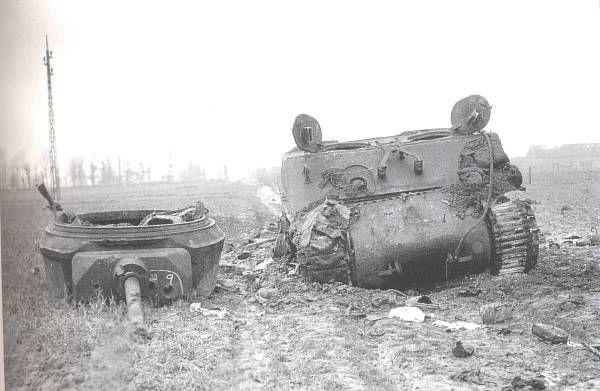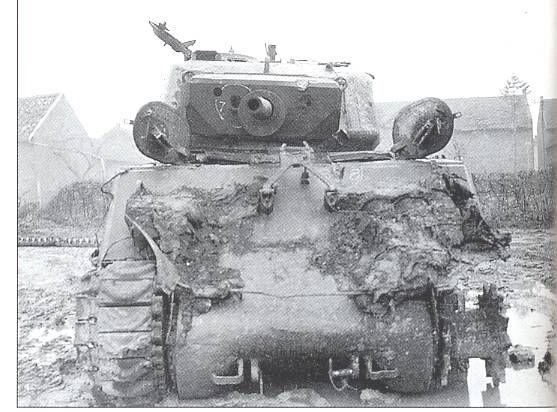- This topic has 24 replies, 6 voices, and was last updated 5 years, 10 months ago by
Deleted User.
-
AuthorPosts
-
21/06/2018 at 05:40 #93688
Deleted User
MemberThis variant of the American workhorse Sherman was noteworthy for its armour upgrade.
indeed, I was reading where 3 out of 4 German 88mm shells failed to penetrate one (the 4th got through the gunner’s slit).
Several of the 250 tanks sent to Europe in 1944 received a bigger gun, too. They were intended as assault tanks and seemed to be pretty good at this role.
I’m wary of building a force comprised of weird and little used variants of weapons but I think I could add one or even two to my US WW2 force.
donald
21/06/2018 at 06:22 #93691 grizzlymcParticipant
grizzlymcParticipantI may be wrong, but I think that they were used a bit like British I tanks. So, like your Tigers, you can beef up an attacking unit with up to a regiment of them.
21/06/2018 at 08:17 #93693Deleted User
MemberI may be wrong, but I think that they were used a bit like British I tanks. So, like your Tigers, you can beef up an attacking unit with up to a regiment of them.
My entire US force is an infantry battalion and four Shermans. A regiment of Jumbos might be considered ‘overkill’.
donald
21/06/2018 at 09:26 #93698 Not Connard SageParticipant
Not Connard SageParticipantThere were fewer than 300 M4A3E2 built, and fewer than half of those had the 76mm gun. At 55? medium/heavy tanks per 1944 battalion, you wouldn’t be equipping entire tank regiments with them.
John Salt will know 🙂
Obvious contrarian and passive aggressive old prat, who is taken far too seriously by some and not seriously enough by others.
21/06/2018 at 10:27 #93701Deleted User
Member. John Salt will know
You think?
21/06/2018 at 10:40 #93702 Not Connard SageParticipant
Not Connard SageParticipant. John Salt will know
You think?
I’d bet your house on it 🙂
Obvious contrarian and passive aggressive old prat, who is taken far too seriously by some and not seriously enough by others.
21/06/2018 at 13:14 #93718Etranger
ParticipantThey tended to be issued at one per platoon in those divisions that received them & were often used at the front of the column, on the grounds that they had a far higher chance of surviving the first (& subsequent) shots than their thinner skinned brethren.
Full records of exactly how the Jumbos were issued are difficult to identify as the tank were often only recorded as ‘Medium Tank M4A3’ with no distinction between a standard M4A3 and an M4A3E2. But partial records have been traced although some do seem to conflict. The first thirty six tanks were issued to the US First Army on the 14th October and were then issued to individual tank battalions. Fifteen to the 743rd, fifteen to the 745th and six to the 746th. On the 18th October, Normandy beach depots recorded having seventeen on hand, twenty four released to Armies and nineteen on route to Third Army. By the 24th October Army allocations for delivery had been confirmed as:
First Army – 105 M4A3E2 Jumbos
Third Army – 90 M4A3E2 Jumbos
Ninth Army – 60 M4A3E2 Jumbos
Clearly someone at 12th Army Group needed a little extra 0work on their basic maths!The last recorded delivery was on the 9th November when 746th Tank Battalion of the First Army was issued a further nine Jumbo’s.
The tanks were well received and the advantages of the additional armor were quickly appreciated. Jumbos were chosen to be the standard point tank any time advances were made with opposition expected. http://www.tanks-encyclopedia.com/ww2/US/m4a3e2-jumbo-assault-tank
There were also various ‘home brewed’ (unit workshop level) modifications to thicken up the frontal armour, including adding an entire Panther glacis plate to the front. https://forum.warthunder.com/index.php?/topic/221398-m4a3-76-w-hvss-39thunderbolt-vii39-premium-tank/ (Ignore the W-T specific comments!)
 21/06/2018 at 14:57 #93729
21/06/2018 at 14:57 #93729 deephorseParticipant
deephorseParticipantAccording to Hunnicutt, in the Sherman bible, 254 Jumbos were built and all had the 75mm gun. It was later proposed that a number of 75mm Shermans be upgraded to 76mm. This upgrade was demonstrated on 24 February 1945 but subsequently limited to the M4A3E2 because it was a simple conversion to make. So no Sherman Jumbo 76s before 24 Feb.!
Play is what makes life bearable - Michael Rosen
21/06/2018 at 17:19 #93733 deephorseParticipant
deephorseParticipantImpressive frontal armour

But not invincible.


Play is what makes life bearable - Michael Rosen
22/06/2018 at 06:46 #93761Etranger
ParticipantBoth those KO’d Jumbos look to have sustained an internal explosion, possibly ammunition ‘cooking off’ after an initial penetration. Interesting that the shell hole is in virtually the same place on both mantlets (the chalk-ringed holes). Potentially very nasty for the TC who was positioned behind that.
22/06/2018 at 08:44 #93769 grizzlymcParticipant
grizzlymcParticipantI bow to the superior knowledge of ET. I thought they were deployed in special units. Looks like a solitary jumbo could lead your other Shermans into danger. I’d echo some 57mm (6 pdr to their friends) and one or two 3 inch.
Looks like the glacis is a trap for young players. The discerning PAK commander takes his jumbo on the mantlet. The glacis is pretty interesting though. Plenty of evidence of shots being deflected rather than just burying themselves in the sloped armour, but I am really interested in the top photo, just left of centre. This one seems to ave rotated into the armour, presumably negating the slope, which clearly hasn’t done it a lot of good.
Have we similar photos of Churchills with shot sticking out of them everywhere?
22/06/2018 at 08:54 #93770 Not Connard SageParticipant
Not Connard SageParticipantHave we similar photos of Churchills with shot sticking out of them everywhere?
Given the different types and calibres of shot, with annotations, I assumed it was a picture taken from test firings on a range. I don’t think the Germans used M62 APC 😉
Obvious contrarian and passive aggressive old prat, who is taken far too seriously by some and not seriously enough by others.
22/06/2018 at 10:59 #93787Etranger
ParticipantThey are test firings, probably into a test piece.
Here’s another one, from a standard Sherman. From http://tankarchives.blogspot.com/2015/04/common-questions-unfair-testing.html

I’m sure that I’ve seen photos of a Churchill used in a similar fashion but I can’t find them online. I did find a summary of the Russian assessment of the Churchill though, which makes for interesting reading. http://tankarchives.blogspot.com/2018/02/british-primer-minister-in-ussr.html
22/06/2018 at 11:14 #93788 Not Connard SageParticipant
Not Connard SageParticipantThose pics seem to illustrate that German armour was prone to fracture and catastrophic failure. More so than Allied tanks?
Still, I suppose once penetration is achieved (oooer!) it’s all academic for the poor buggers inside.
Obvious contrarian and passive aggressive old prat, who is taken far too seriously by some and not seriously enough by others.
22/06/2018 at 11:17 #93789Deleted User
MemberThose pics seem to illustrate that German armour was prone to fracture and catastrophic failure. More so than Allied tanks? .
Interesting. The myth of Nazi military superiority is pretty thin in ’44 into ’45.
It would not surprise me that their vaunted tanks were increasingly made of substandard steel as well as being dodgy mechanically.
donald
22/06/2018 at 11:33 #93791Etranger
ParticipantThose pics seem to illustrate that German armour was prone to fracture and catastrophic failure. More so than Allied tanks?
.
There are a few theories about that, one being that late war German armour plate was indeed more brittle due to a deficiency in some of the rare metals used (?Molybdenum, replaced by Vanadium), or possibly the photos are of tanks that have been hit repeatedly & that the repeated hammering destroyed the armour integrity which then failed with catastrophic effect, as would any armour subjected to the same damage. http://tankarchives.blogspot.com/2013/08/german-armour-quality.html
22/06/2018 at 12:45 #93796 grizzlymcParticipant
grizzlymcParticipantIK am pretty sure it was substitution of coper for nickel in the panther’s glacis which made it susceptible to cracking rather than penetration.
22/06/2018 at 13:44 #93807 Not Connard SageParticipant
Not Connard SageParticipantThose pics seem to illustrate that German armour was prone to fracture and catastrophic failure. More so than Allied tanks? .
There are a few theories about that, one being that late war German armour plate was indeed more brittle due to a deficiency in some of the rare metals used (?Molybdenum, replaced by Vanadium), or possibly the photos are of tanks that have been hit repeatedly & that the repeated hammering destroyed the armour integrity which then failed with catastrophic effect, as would any armour subjected to the same damage. http://tankarchives.blogspot.com/2013/08/german-armour-quality.html
Yebbut, that Sherman glacis you posted has taken multiple hits and hasn’t cracked. Ditto deephorse’s pic.
This Panther has taken one hit, which probably ruined the driver’s day, the plate seems to have deformed as well as cracked and sheared at the glacis weld.

Obvious contrarian and passive aggressive old prat, who is taken far too seriously by some and not seriously enough by others.
22/06/2018 at 13:49 #93808 Not Connard SageParticipant
Not Connard SageParticipantAnd this Panther turret has taken three deflected hits, and given up the ghost.
I wonder how much spalling happened on the inside when it went?
Obvious contrarian and passive aggressive old prat, who is taken far too seriously by some and not seriously enough by others.
22/06/2018 at 15:38 #93809Etranger
ParticipantWe’re getting a long way away from Cobra King….
With the second Panther in particular, multiple shots have been taken at it, possibly by different crews at different times, since it was SOP to shoot at any tank that wasn’t obviously already destroyed (exploded, burnt out etc) in case it was still “alive”. With that amount of damage on the outside, it’s probable that any one of those hits was lethal to the turret crew.
This Tiger has copped a similar degree of attention, without an externally obvious “KO”. The missing track is probably why it’s there of course.There’s no doubt that there was something ‘going wrong’ with the quality of the German armour in the latter part of the war. Panthers seem to be the most affected, judging by the numerous photos.
The Tiger II wasn’t immune either.
“Shot #1. Target: upper front plate. Shell: 122 mm HE-fragmentation.
Result: spalling across an area 300 mm by 300 mm. The welding seam between the upper front plate and the machine gun port burst on 3/4 of its circumference. Internal bolts holding the machine gun ball were torn off. The welding seam between the upper front plate and the right side burst, and the right side was displaced by 5 mm. The tank caught fire internally.”From http://tankarchives.blogspot.com/2013/03/is-2-vs-german-big-cats.html , which makes sobering reading. (Don’t bother about the comments section, full of trolls and panzer fan-bois).

This Tiger appears to have ‘sunk’!
22/06/2018 at 17:03 #93819 Not Connard SageParticipant
Not Connard SageParticipantWe’re getting a long way away from Cobra King….
Well yes, but it keeps things interesting 🙂
With the second Panther in particular, multiple shots have been taken at it, possibly by different crews at different times, since it was SOP to shoot at any tank that wasn’t obviously already destroyed (exploded, burnt out etc) in case it was still “alive”.
Are we looking at the same photo? Because it looks to me as though 3 (or possibly 2 given the upper two gouges seem to be perfectly aligned) deflected shots have arrived from the same elevation. It’s quite possible that the tank was disabled before the turret hits, but there seem to be no other local strikes that explain the turret’s cracking inward in all directions. That glancing blows with no obvious penetration caused such damage suggests that German (rolled?) steel was a bit rubbish.
It would be interesting to know the calibre of the gun that did the damage.
Obvious contrarian and passive aggressive old prat, who is taken far too seriously by some and not seriously enough by others.
22/06/2018 at 22:50 #93837 grizzlymcParticipant
grizzlymcParticipanti’mv interested in the complete absence of glancing blows on the first King tigger. It’s almost as though it was made of mild steel, contrast that with the Sherman piccies where the sloped glacis is clearly doing the deflection thing.
Ocho, sorry about your Jumbo thread – you can have one.
22/06/2018 at 22:53 #93839Deleted User
Member. With the second Panther in particular, multiple shots have been taken at it, possibly by different crews at different times, since it was SOP to shoot at any tank that wasn’t obviously already destroyed (exploded, burnt out etc) in case it was still “alive”’!
I have read that a knocked out tank might suffer a few more rounds after the battle to ensure its recovery was marginal.
donald
22/06/2018 at 23:47 #93840 irishserbParticipant
irishserbParticipantgrizzlymc, the physical properties and design of the penetrator may be part of the explanation for the differences in the damage to the plate. Additionally, armor manufactured using different processes/methods will exhibit different properties, and different damage under the same circumstances.
The damaged panzer turret side is interesting. Knowing the order of the impacts would help us understand the damage, additionally, inspection of the fracture surfaces would allow us to determine how the failure occurred and how it grew (maybe indicate the order of the impacts). Note that the cupola is damaged, and that (or those) impact(s) may have contributed to the damage that we see. Also, if more of the turret were in the field of view, we may find that other impacts were associated with the damage.
Regarding the damage to the Jumbo turrets, gunners could be and were sometimes instructed to aim, not only at the tank target, but at specific weak spots of tanks. Note the number of hits on the second jumbo mantlet, and at least two near misses of the mantlet, while most of the tank has no shell damage. It appears that the gunner or gunners shooting at it were aiming for specific areas of the tank. Though hoping for a hole in one shot through a the tank’s eyeball must be a bit of a long shot.
23/06/2018 at 01:51 #93841Deleted User
Member. Ocho, sorry about your Jumbo thread – you can have one.
Order just placed. I get 2 via Armourfast……so I might push the envelope a bit.
donald
-
AuthorPosts
- You must be logged in to reply to this topic.




